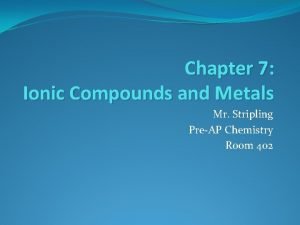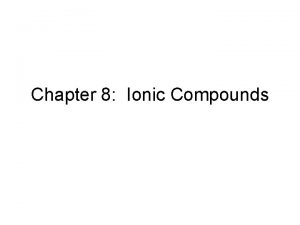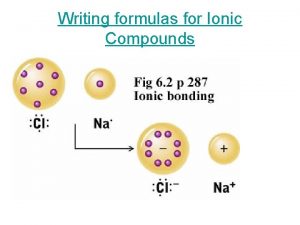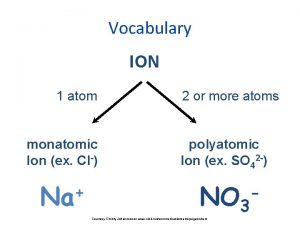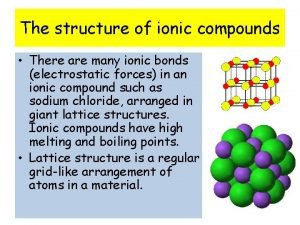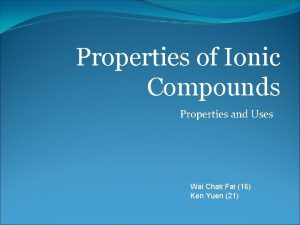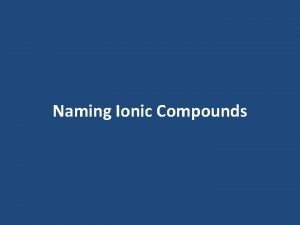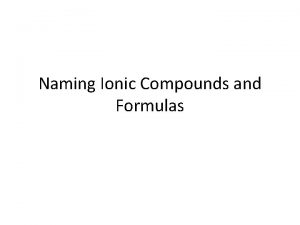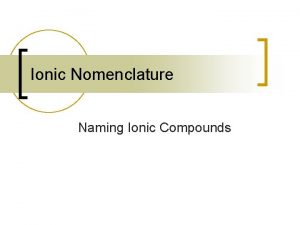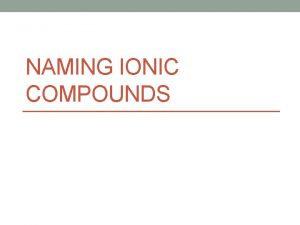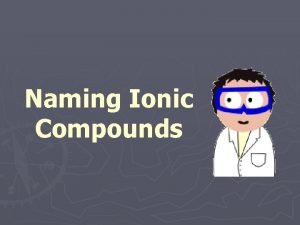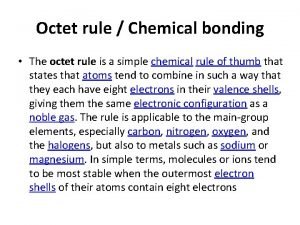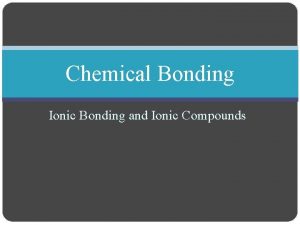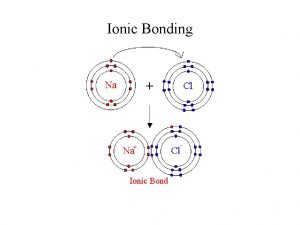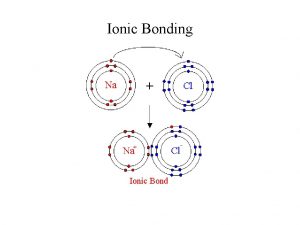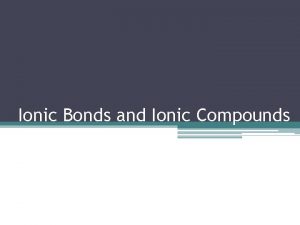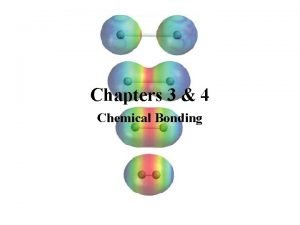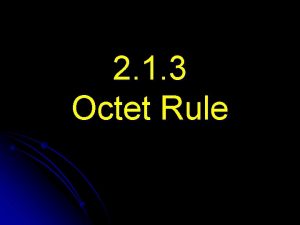Ionic Compounds Chapter 9 Octet rule Octet rule
















- Slides: 16

Ionic Compounds Chapter 9

Octet rule • Octet rule: Atoms in a compound will lose, gain or share electrons in order to achieve a stable noble gas configuration. • It is the electrons in the outer shell that participate in these changes to create bonds

Valence electrons • The valence electrons of an atom are defined as the electrons in the outermost shell of the uncharged atom. • The number of valence electrons of an uncharged atom is equal to the group number for main group elements.

Dot structures • In Lewis dot structures, the valence electrons are represented by dots. • Lewis dot structures play a more important role in covalent bonding than ionic bonding. • Sodium, in group I has 1 valence electron • Carbon in group IV has 4 valence electrons.

Dots for common elements

Types of bonding • metal + non-metal leads to ionic bonding. – the metal will lose electrons to become positively charged. – the non-metal will gain electrons to become negatively charged. – the ionic compound is held together by the electrostatic attraction between the positive and negative charges.

Salt and Lewis Structures • The sodium and chlorine combine in a 1: 1 ratio.


Does it have to be a 1: 1 ratio? No! • All ionic compounds must have no overall charge so positive charges must equal negative charges. • Example sodium oxide: Na 2 O

The Switcheroo Rule Note that the cation is written first and the anion second.

A Caveat to the Switcheroo rule • If you can divide by an integer greater than one, you must do so. • Mg 2+ and O 2 - form Mg. O not Mg 2 O 2 2 2 Mg. O

Polyatomic ions • Polyatomic ions are groups of covalently bound atoms that act like a single ion. • Example: nitrate NO 3 - combines with Mg 2+ to form Mg(NO 3)2. • Note the use of ( ) to identify that it is 2 nitrates. • Pb 4+ and OH- form: Pb(OH)4

ten polyatomic ions

Rules for naming simple ionic compounds. 1. Name the metal by its elemental name. 2. Name the nonmetal by its elemental name and an ide ending. 3. Name metals that can have different oxidation states using roman numerals to indicate positive charge. Example Fe 2+ is Iron(II) (See table “Charges of some Common Monatomic ions” to determine which metals can have more than one positive charge. ) 4. Name polyatomic ions by their names. Na. Cl is sodium chloride, Copper(II)hydroxide is Cu(OH)2

Ionic Nomenclature Practice The Rule: Name the cation Name the anion • • • Co. Cl 2 Sn(Cl. O 3)2 K 2 S NH 4 C 2 H 3 O 2 Mg(NO 3)2 Ag. I Cobalt(II) chloride Tin(II) chlorate Potassium sulfide Ammonium acetate Magnesium nitrate Silver iodide

More Practice On the Web • • Nomenclature Activity game Worksheet More Worksheets
 Covalent and ionic bonds venn diagram
Covalent and ionic bonds venn diagram Properties of ionic compounds
Properties of ionic compounds Chemistry chapter 7 ionic and metallic bonding
Chemistry chapter 7 ionic and metallic bonding Ionic compounds and metals chapter 7
Ionic compounds and metals chapter 7 Chapter 7 ionic compounds and metals assessment answer key
Chapter 7 ionic compounds and metals assessment answer key Monotomic ion
Monotomic ion Criss cross method steps
Criss cross method steps Ternary ionic compounds
Ternary ionic compounds Monatomic ion examples
Monatomic ion examples Brittle ionic compounds
Brittle ionic compounds Solubility formula class 9
Solubility formula class 9 Uses of ionic compounds
Uses of ionic compounds Cl-1 ion name
Cl-1 ion name Naming ionic compounds
Naming ionic compounds Writing names for ionic compounds
Writing names for ionic compounds Ternary ionic compounds
Ternary ionic compounds Rules for naming ionic compounds
Rules for naming ionic compounds



